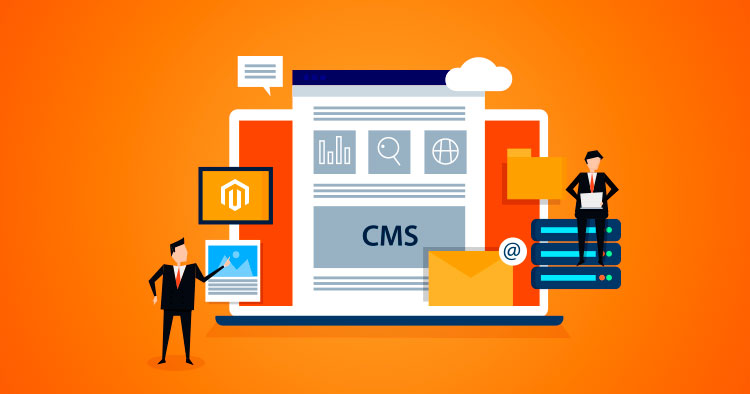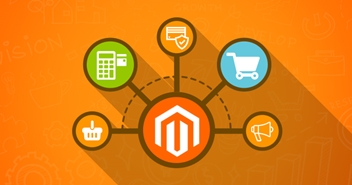
Gone are the days when you would need to hire a developer for changing content on your ecommerce business websites.
These days, everyone can create a website without writing a line of code. This is made possible through Content Management Systems (CMS for short). A CMS is a platform that simplifies the entire process of creating pages and adding/modifying content.
There has been an explosion in the CMS market and there are several very robust CMS on the market that offer a complete solution to all your content vows. And therein lies the issue: there are just too many good CMS out there, and choosing the right Content Management System for your ecommerce website can be a challenge.
I have got a tip for you: If you are looking for a CMS hosting platform for your ecommerce store, Magento CMS is the perfect choice.
Now the question is …
Why Choose Magento CMS?
Magento content management system is a full-featured and robust platform especially built for ecommerce sites. Magento can be used for ecommerce sites of all sizes to explore limitless possibilities for growing the business.
Once you have developed your store on Magento and have selected best Magento hosting, you don’t have to worry about scaling your business because it can scale up to keep pace with your business. If you need to extend the default features and incorporate additional functionalities, simply install extensions and themes created by third-party developers.
Some Magento Facts
But don’t take my word – Here are some facts that will convince you to give Magento CMS for your ecommerce site:
- Magento powers 250000+ sites globally, with a large chunk of the number located in the US.
- It is the third most popular CMS in the Top 10k sites in the Open Source category.
- It is the fifth most popular CMS in the Top 1 Million sites in the Open Source category.
Source: BuiltWith
Magento content management system allows anyone to create a completely new page with multiple sections, each with multiple widgets. Similarly, you can edit existing pages and change the design elements to bring it to the accepted Magento 2 CMS standards.
Magento CMS Elements
Magento CMS elements are essential for creating pages that fit into the website’s theme. For instance, these elements can be used to create a shop page consisting of banners with featured products at the top and other products below. The Magento 2 CMS elements are simple to use and add a modern touch to design.

Pages
You can use the Magento CMS Page module to create a page for your store. This page can include essential design elements including text, images, blocks, widgets and links to other pages.

- Core Content
If you have already installed Magento sample data, you will find many content pages are already created by default. These content pages cover almost all important business scenarios and requirements for an ecommerce store. The list include:
- Home
- Privacy Policy
- 404 – Not Found
- Enable Cookies
- Service Unavailable
- About Us
- Customer Service
Through the Magento CMS, you can easily modify these pages to convey the right message and brand image of your ecommerce store.
- Workspace Controls
This a great Magento CMS page tool that allows you to quickly find a page, perform bulk actions on multiple pages or make quick changes to any existing page.

- Adding a New Page
The process of adding a new page to a Magento website is simple. You can add any kind of content in the form of text, images, blocks of content or widgets to a newly created Magento CMS page. While Magento CMS does make sure the pages are search engine optimized, you should also put in efforts so that the pages rank well in SERP.
- Using the Editor
Magento 2 CMS’s editor has a familiar interface that simplifies the process of editing the content of any page. For experienced users, the module offers a toggle for switching to the HTML mode.
Magento CMS Blocks
Magento CMS Blocks are static content blocks that add different types of content sections to any area of the page. Magento CMS blocks are used to display static information (text, images, and videos), as well as dynamic information(that is often extracted from the DB or other similar sources) which can be displayed through widgets.

- Adding New Blocks
Once you have created a new Magento 2 CMS block, it can be added to any page of the website, group of pages or even inside another block. Magento Blocks Workspace is similar to Magento CMS Page Workspace and helps you perform similar operations and changes.
- Positioning Blocks
To position a block in a page or a page layout control is done by defining them through XML widgets. The Magento 2 CMS blocks can then be placed at specific locations on the page or even within product and category areas.
Widgets
Widgets are actually snippets of code that contain references to website blocks that can be used to display a wide range of content formats. The widgets are particularly useful for displaying real-time dynamic data, thus increasing the chances of the visitor to engage and convert into a potential lead.
Widgets allow Magento CMS users to create a better ecommerce store by creating better marketing campaigns for landing pages, and displaying promotional content on any location of the website. Widgets can also display external content, real-time and engaging activities, or similar functionalities.

Design and Theme
Through Magento 2 CMS, you can create a page with multiple layouts, do simple HTML changes or give your store a completely new look by installing a new theme. All this can be done through the Design and Theme section.
Design Menu
Magento offers easy to use design options which can be used to make simple changes to the ecommerce store. You will find many professionally designed ecommerce themes on Magento Marketplace and other market places. These themes are more than just cosmetic makeovers for your store. Magento themes provide essential functionalities for store customization.
If you are familiar with an object-oriented environment in which each page is actually built by combining multiple components, Magento is a very good choice for you.
Page Setup
This section is used to set the basic properties of the Magento page. It offers a set of standard HTML tags which are used to define different elements of the page such as fonts, color, size, and background color. It is also used to manage logos in the header, copyright notices in footer and other page settings. Many other basic settings for the page can be done from the Admin section.
Page Layout
These page layouts are like the structure of the building where each room has a specific layout that matches the function of the page. Similarly, each page of the Magento store consists of different sections and containers which covers different elements of the page (footer, header, content area and etc).
Pages might have different layouts consisting of multiple columns; each column is assigned a specific or multiple layouts to be used as the default for the Content Management System.
Magento page layouts are designed to fill the available space according to the assigned section assigned. For instance, if you wish to change a 3-column layout to 2-column, the main content would expand and fill the space. If you revert back, the text would automatically get adjusted. This liquid layout behavior ensures that you do not have to write (or reframe ) content every time you need to change the page layout.
Themes
Magento themes consist of layout files, translation files, template files, and skins. The skin actually defines the view of the website and has the CSS, images, and JavaScript which collectively defines the visual presentation and customer experience of your store. To give your website a new look, you can install a completely new theme or customize your current theme.
In the End …
Magento CMS is a good choice for starting an ecommerce store. Magento content management system is very powerful and has all the features that you require for managing the ecommerce store easily and scale your business.
Abdur Rahman
Abdur Rahman is the Magento whizz at Cloudways. He is growth ambitious, and aims to learn & share information about Ecommerce & Magento Development through practice and experimentation. He loves to travel and explore new ideas whenever he finds time. Get in touch with him at [email protected]


